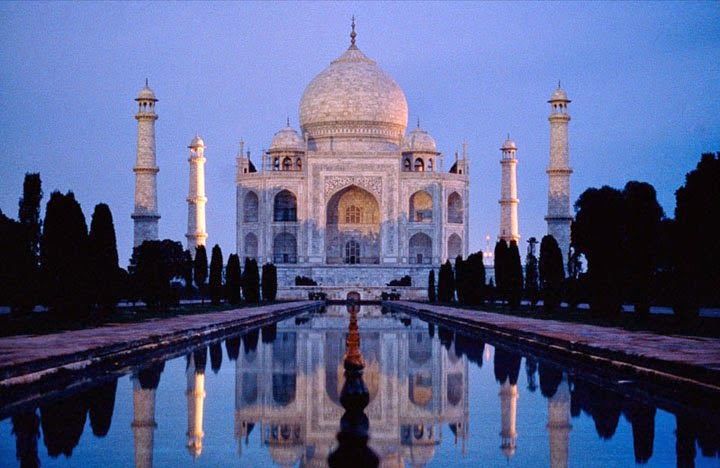Taj Mahal History: History of The Taj Mahal. During the time of the Indian rebellion of 1857, the Taj Mahal was defaced by British soldiers and government officials, who chiseled out precious stones and lapis lazuli from its walls. At the end of the 19th century, British viceroy Lord Curzon ordered a massive restoration project. History of the Taj Mahal. India's most famous monument, the Taj Mahal is also the most perfect mausoleum of Arab-Indian architecture. This page explains when, how and why it was built, but it also gives information about its history through the years. Miele induction cooktop instructions. But first of all it should be noted that its history is very unrestrained. Jun 13, 2011 - The Taj Mahal is an enormous mausoleum complex commissioned in. Celebrated structures and a stunning symbol of India's rich history.
The Taj Mahal (more often from Persian and Arabic, 'crown of palaces', pronounced ) is a white marble mausoleum located on the southern bank of Yamuna River in the Indian city of Agra. It was commissioned in 1632 by the Mughal emperor Shah Jahan (reigned 1628–1658) to house the tomb of his favorite wife of three, Mumtaz Mahal. Construction of the mausoleum was essentially completed in 1643 but work continued on other phases of the project for an additional ten years. The Taj Mahal complex is believed to have been completed in its entirety in 1653 at a cost estimated at the time to be around 32 million Indian rupees ($ 501,000 US) which in 2015 would be valued at around 52.8 billion Indian rupees ($827 million US). The construction project employed around 20,000 artisans under the guidance of a board of architects led by Ustad Ahmad Lahauri. The domed marble tomb is part of an integrated complex consisting of gardens and two red-sandstone buildings surrounded by a crenellated wall on three sides.
The Taj Mahal is regarded by many as the best example of Mughal architecture and is widely recognized as 'the jewel of Muslim art in India'. It is one of the world’s most celebrated structures and a symbol of India’s rich history.

Designated a UNESCO World Heritage Site in 1983, the Taj Mahal attracts some 3 million visitors a year. To know more about Tajmahal please visit - This Video is a part of National Repository of Open Educational Resources Original Video Source.
History Of Taj Mahal India
Story of Taj Mahal, the magnificent monument that stands at the heart of India has a story that has been melting the hearts of millions of listeners since the time Taj has been visible. A story, that although ended back in 1631, continues to live on in the form of Taj and is considered a living example of eternal love. It's the love story of Shah Jahan and Mumtaz Mahal, two people from the course of history who set an example for the people living in present and the future to come. An English poet, Sir Edwin Arnold best describes it as 'Not a piece of architecture, as other buildings are, but the proud passion of an emperor's love wrought in living stones.' The story that follows next will prove why the statement is true.
Seven Wonders Of The World
Shah Jahan, initially named Prince Khurram, was born in the year 1592. He was the son of Jehangir, the fourth Mughal emperor of and the grandson of Akbar the Great. In 1607 when strolling down the Meena Bazaar, accompanied by a string of fawning courtiers, Shah Jahan caught a glimpse of a girl hawking silk and glass beads. It was love at first sight and the girl was Mumtaz Mahal, who was known as Arjumand Banu Begum at that time.
Description Of Taj Mahal In India

At that time, he was 14 years old and she, a Muslim Persian princess, was 15. After meeting her, Shah Jahan went back to his father and declared that he wanted to marry her. The match got solemnized after five years i.e., in the year 1612. Percakapan perkenalan bahasa inggris singkat. It was in the year 1628 that Shah Jahan became the Emperor and entrusted Arjumand Banu with the royal seal. He also bestowed her with the title of Mumtaz Mahal, meaning the 'Jewel of the Palace'.
Prince of persia 2010 movie. Next up for the film is the U.K. It opened in first place in Russia with $3.33 million on 949 screens, while it also took top spot in South Korea with $3.04 million on 565 screens over the weekend and $3.76 million in total.
Though Shah Jahan had other wives also, but, Mumtaz Mahal was his favorite and accompanied him everywhere, even on military campaigns. In the year 1631, when Mumtaz Mahal was giving birth to their 14th child, she died due to some complications. While Mumtaz was on her deathbed, Shah Jahan promised her that he would never remarry and will build the richest mausoleum over her grave. It is said that Shah Jahan was so heartbroken after her death that he ordered the court into mourning for two years. Sometime after her death, Shah Jahan undertook the task of erecting the world's most beautiful monument in the memory of his beloved.